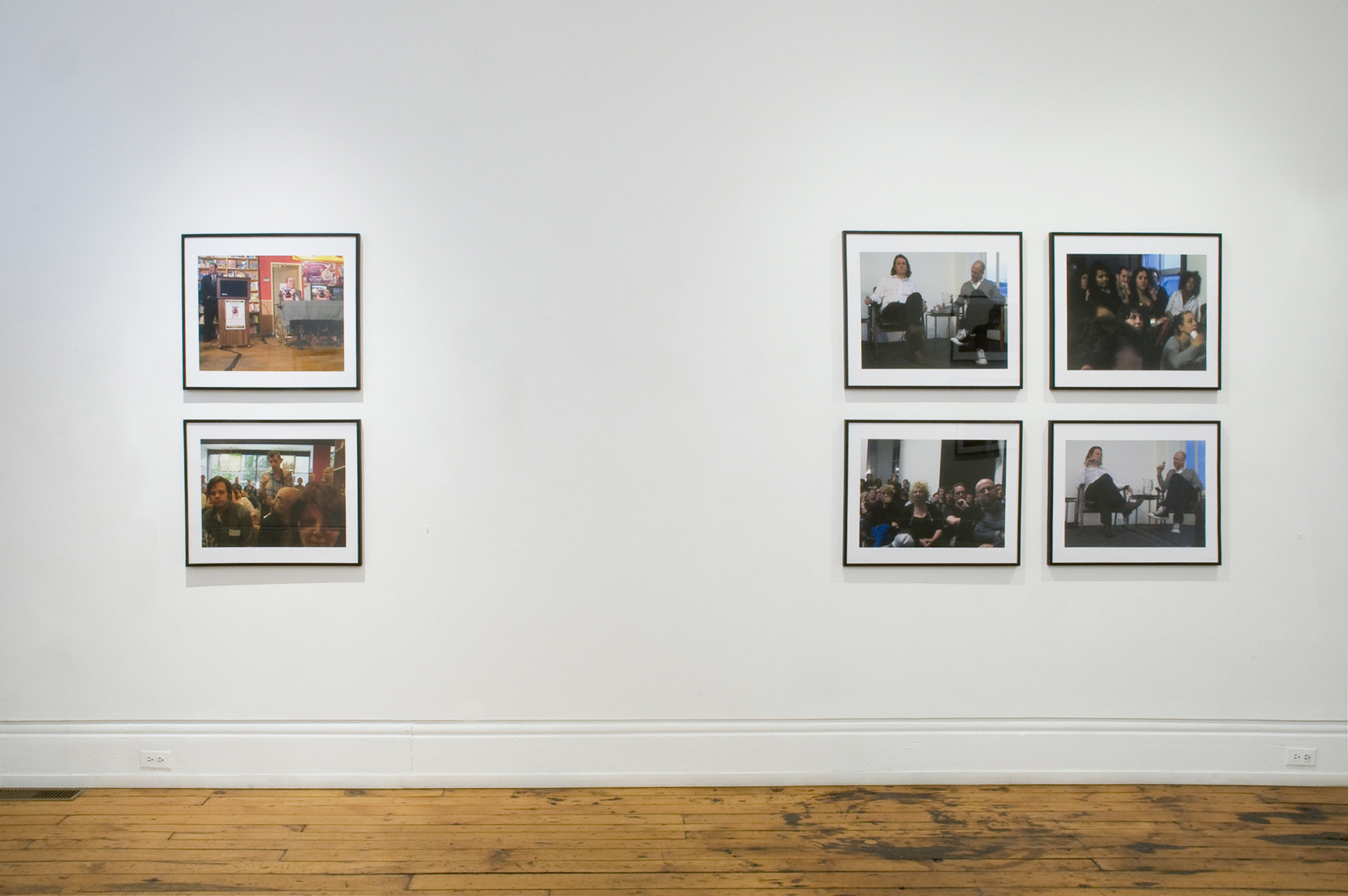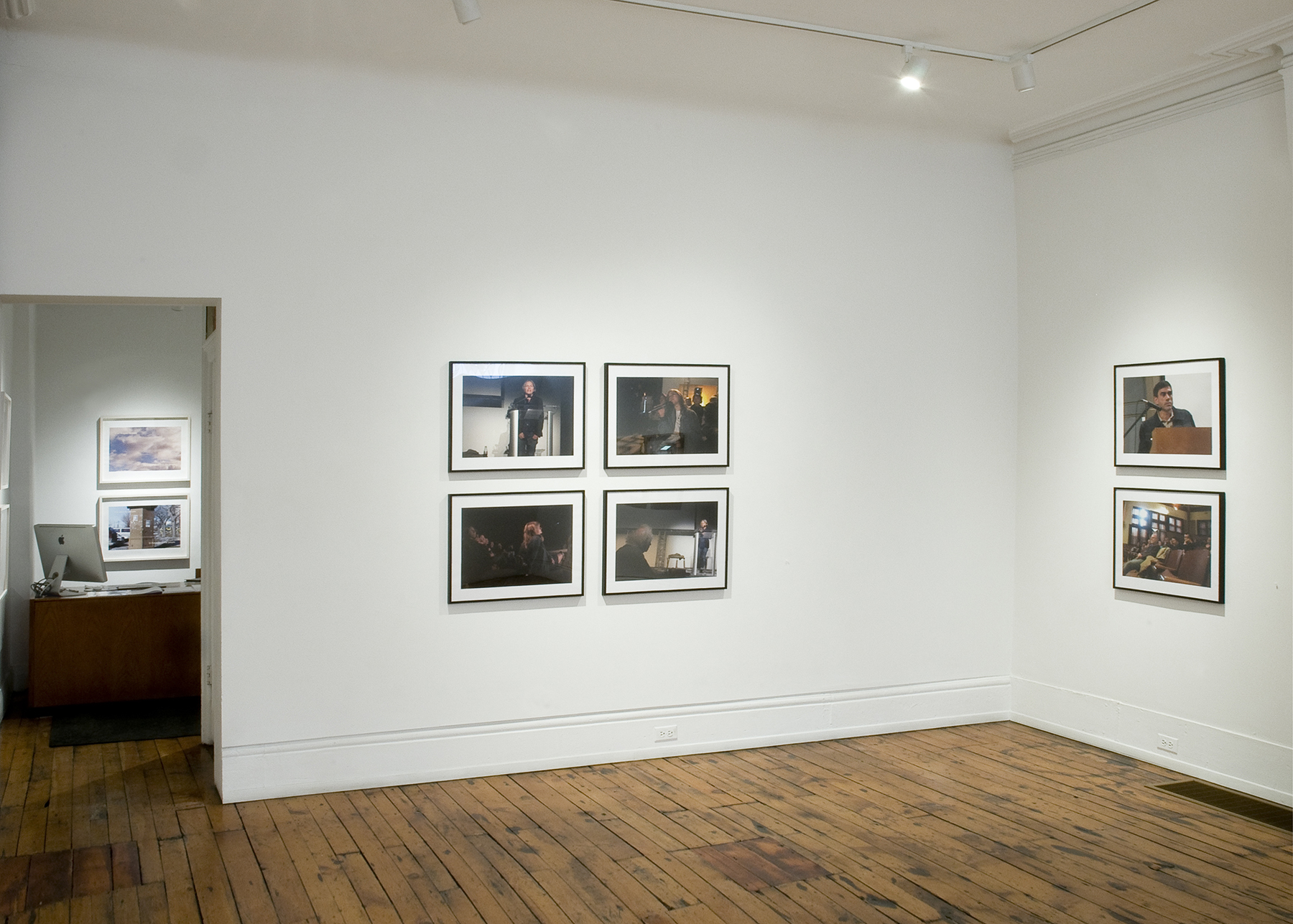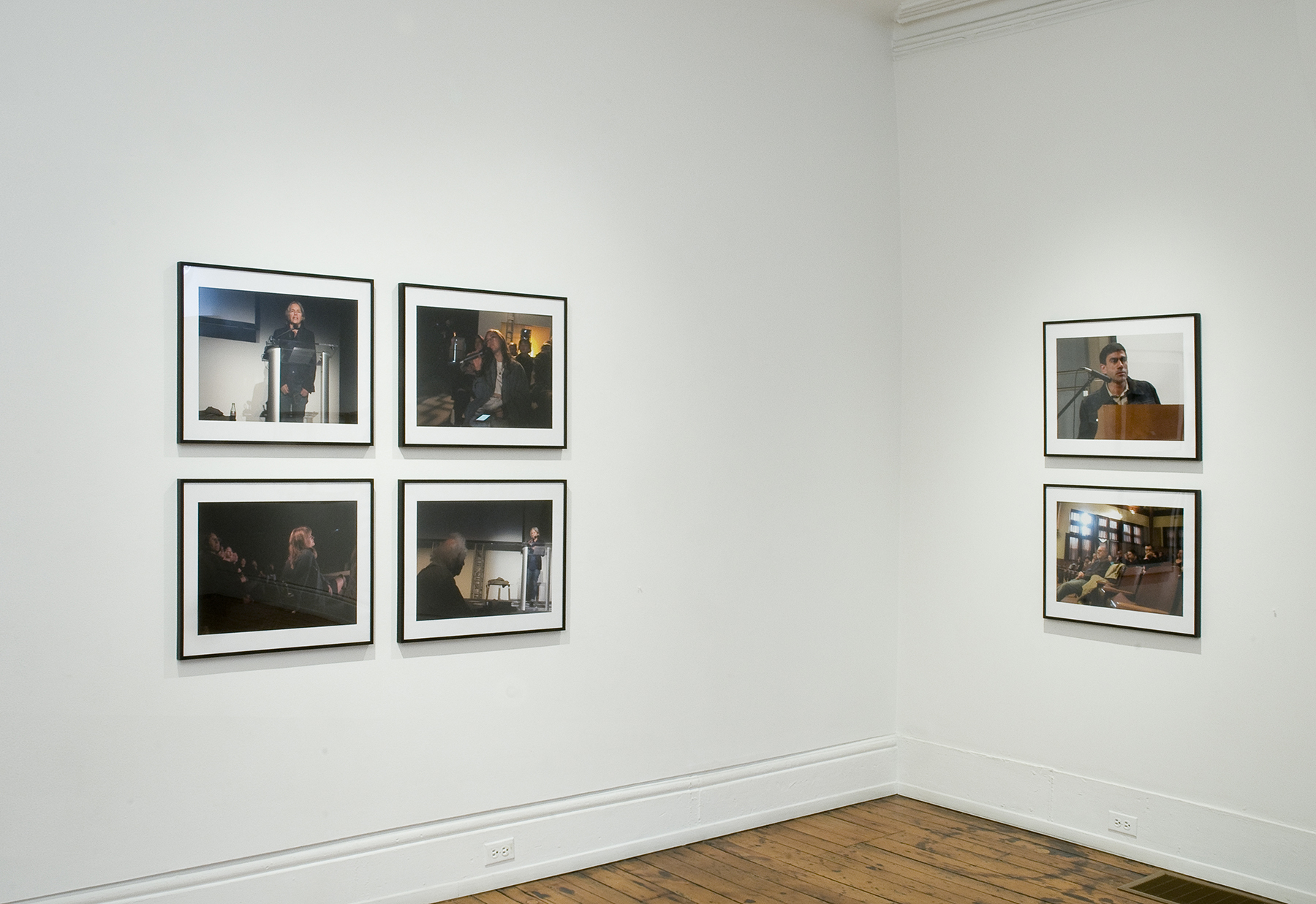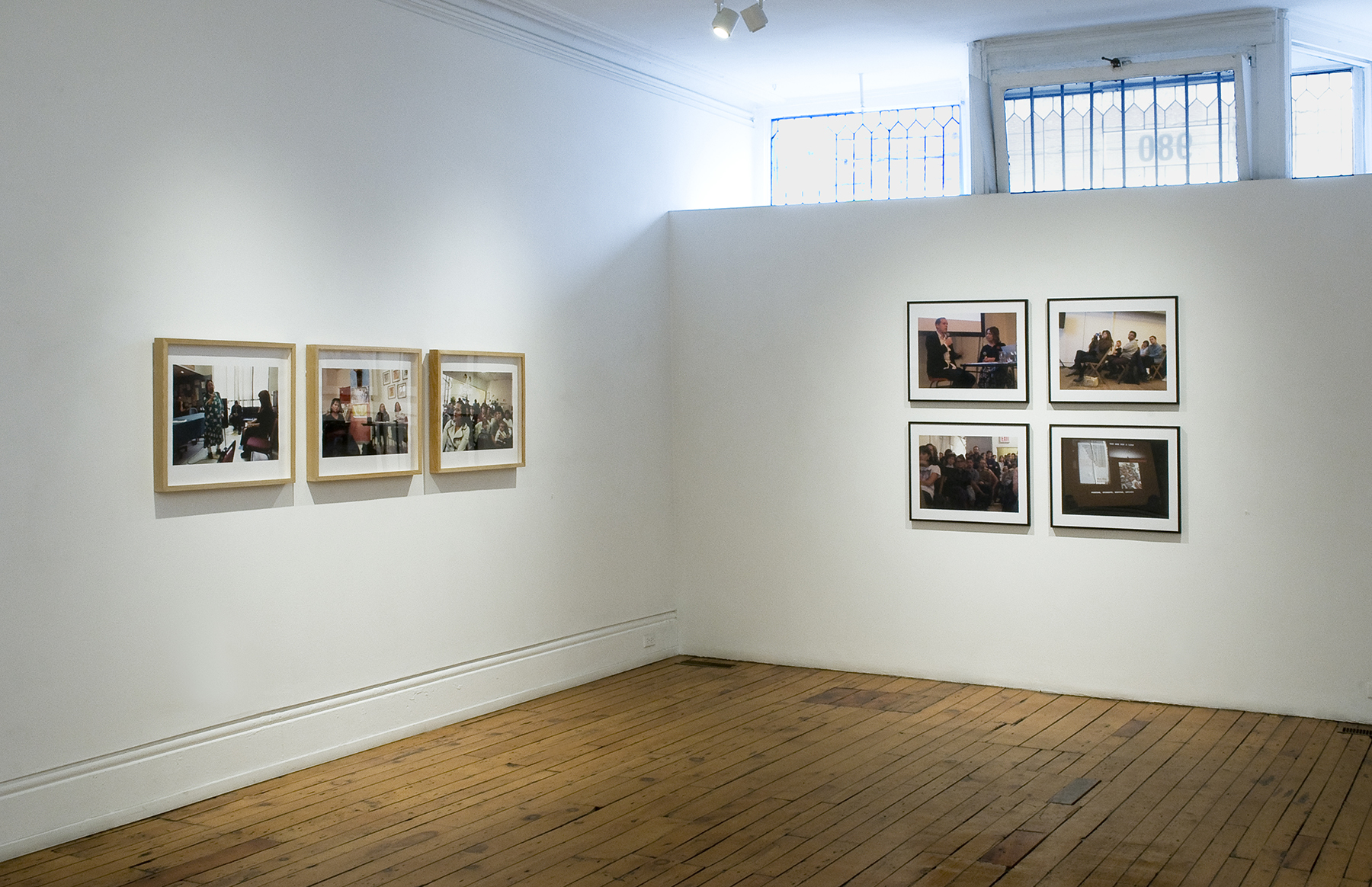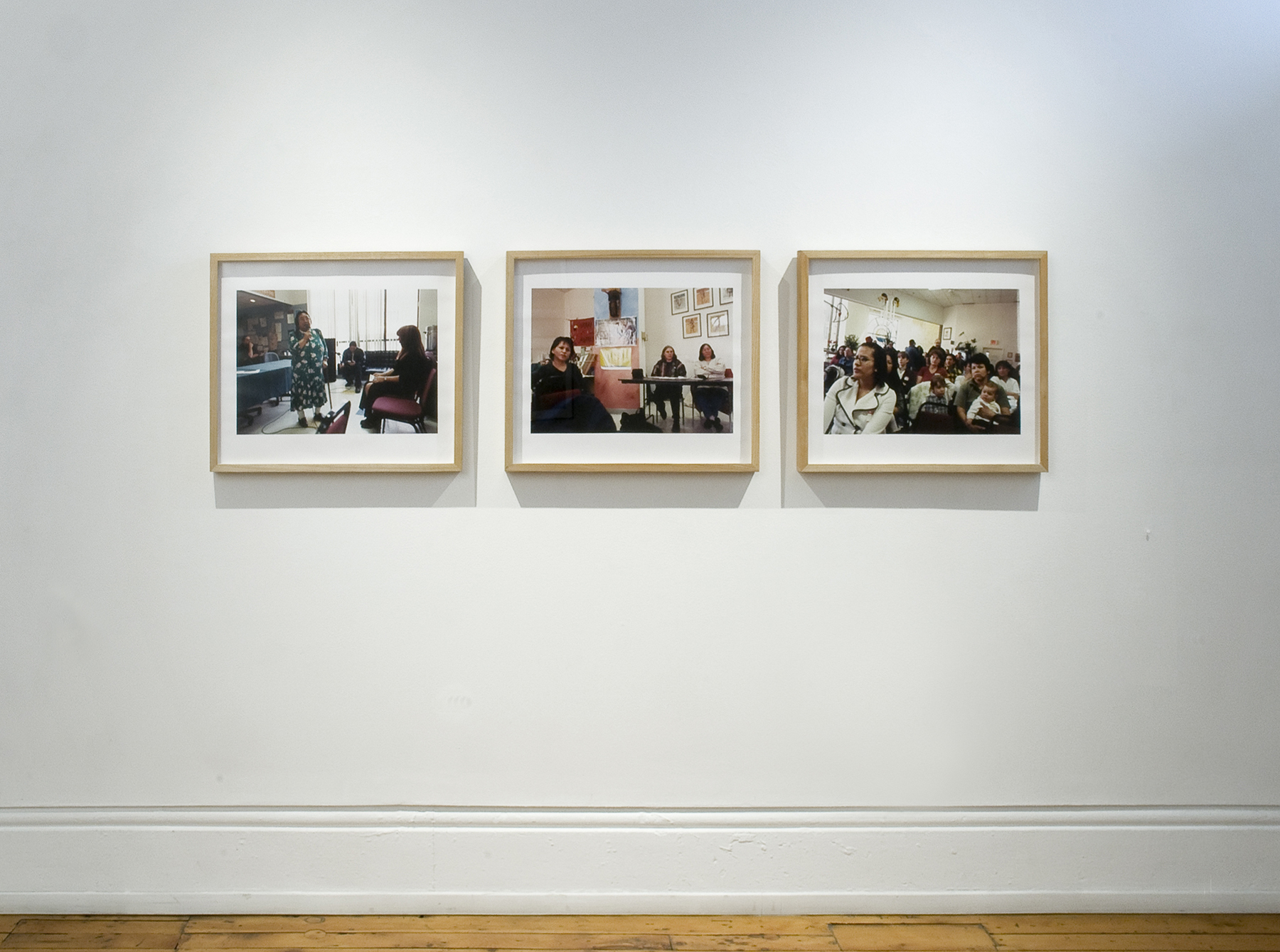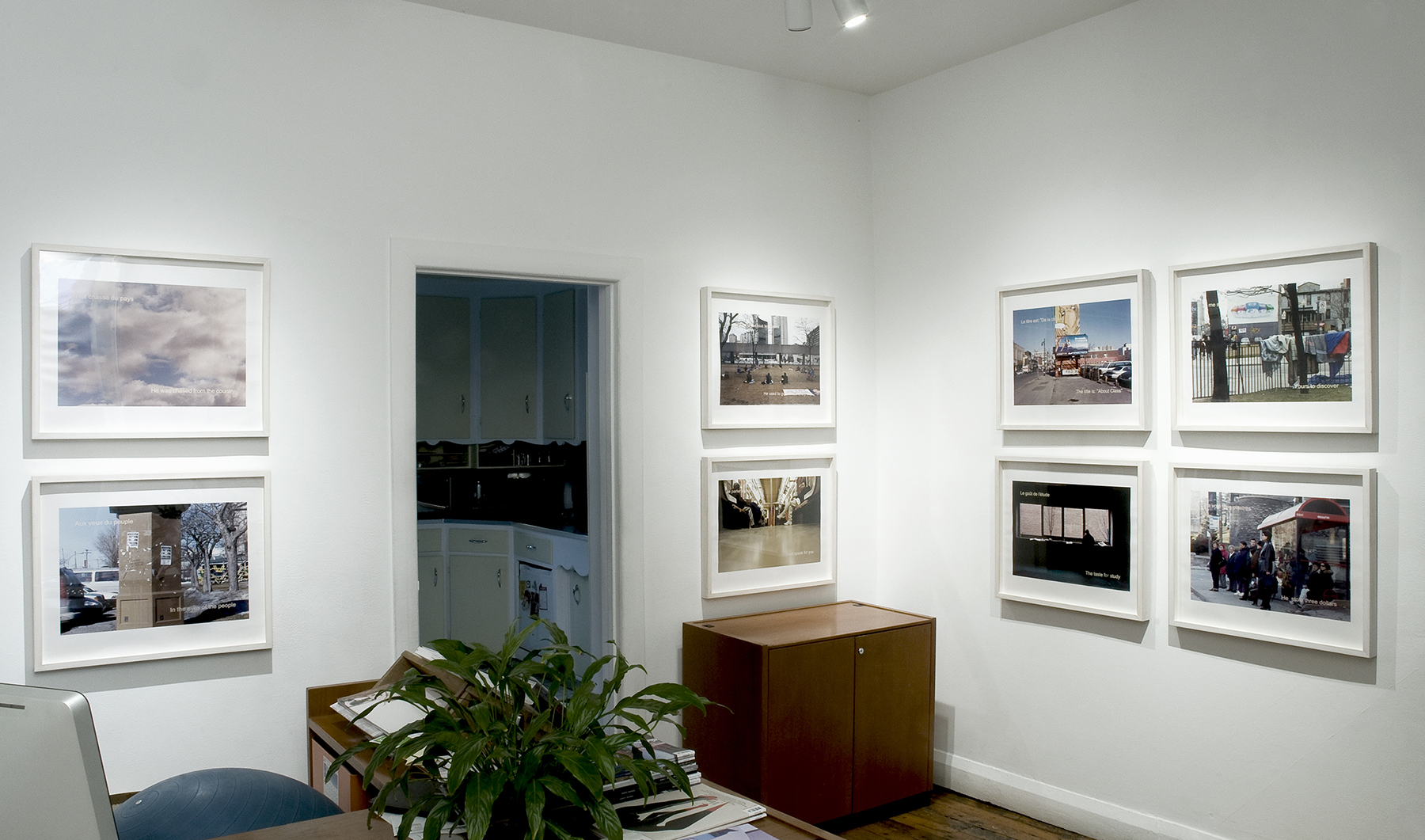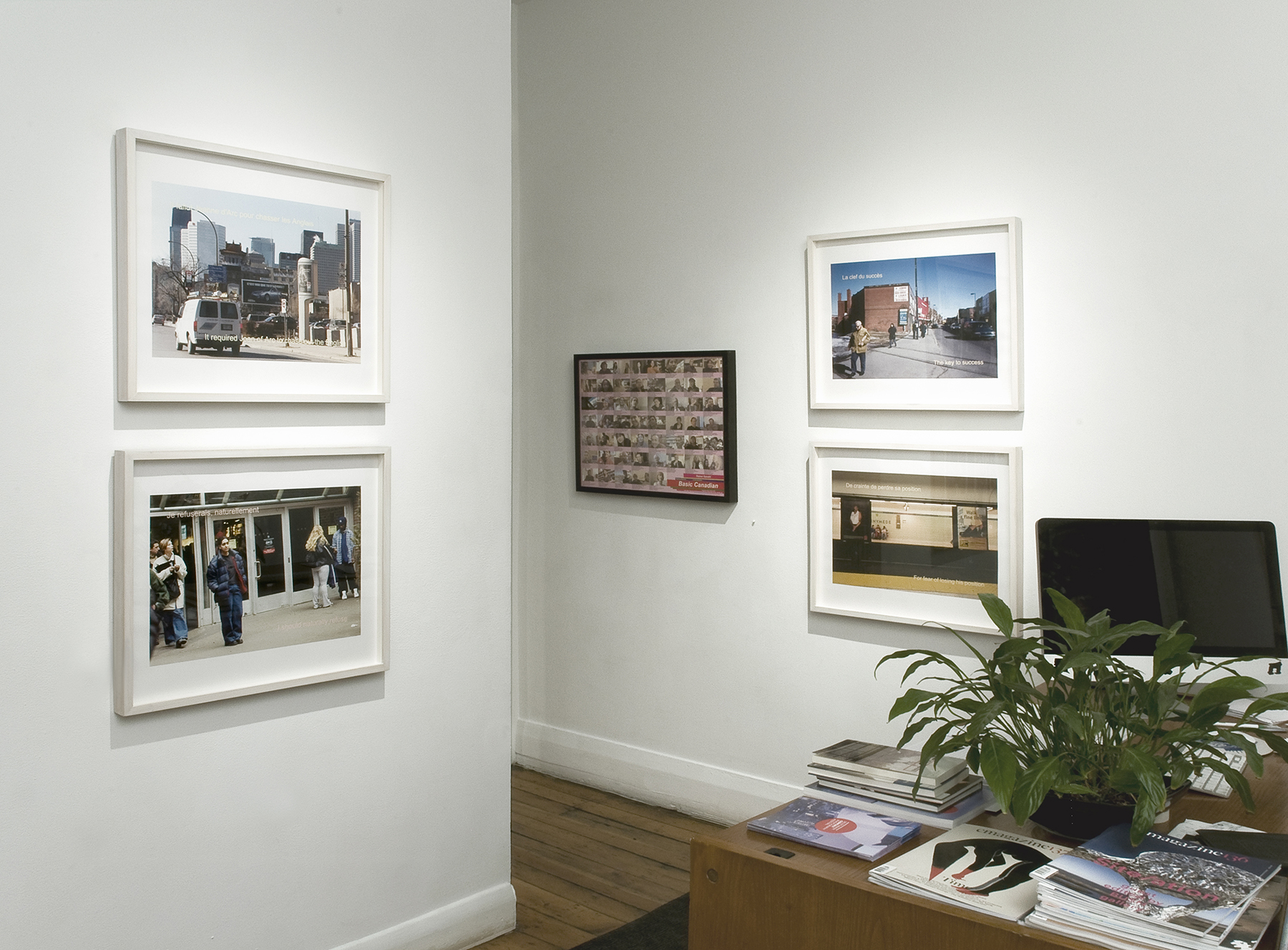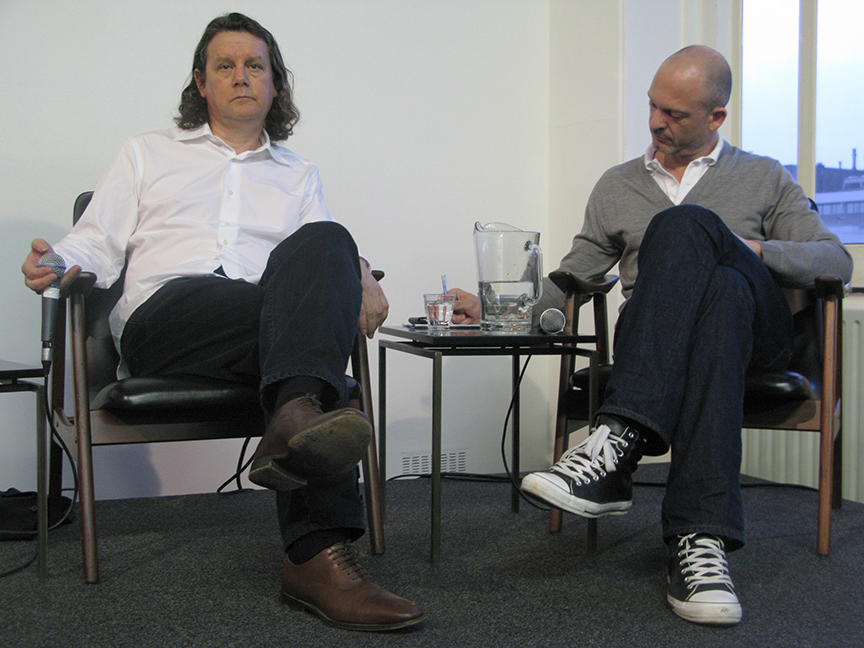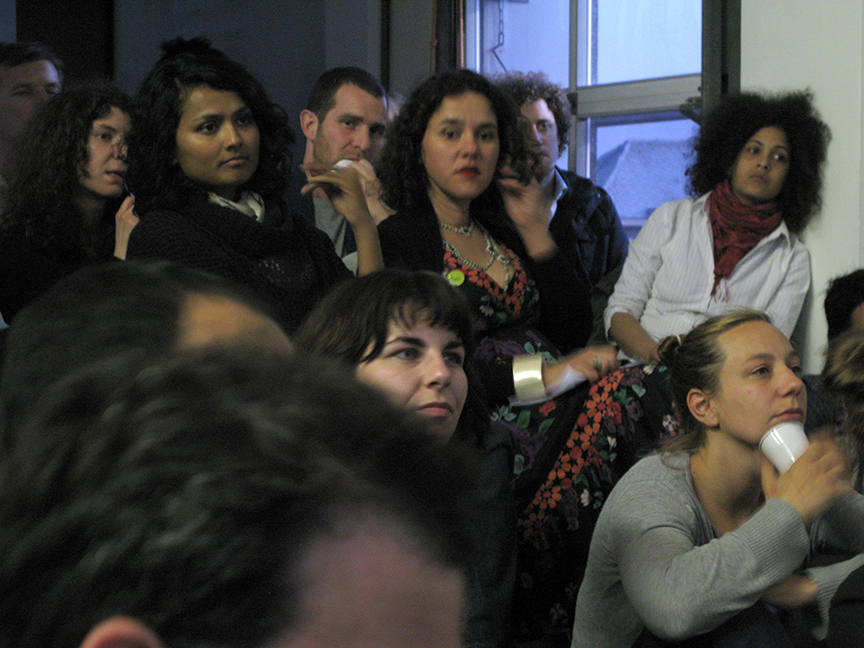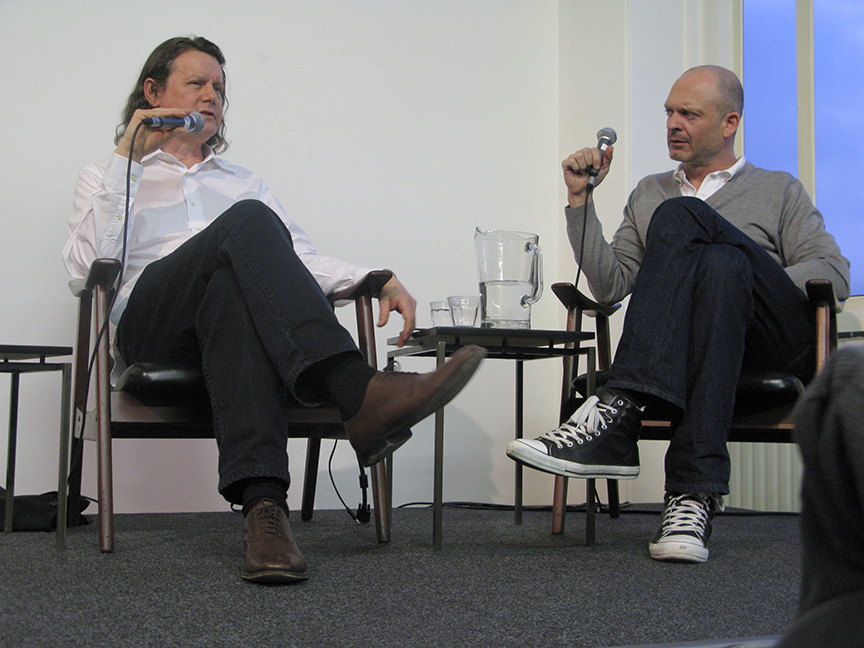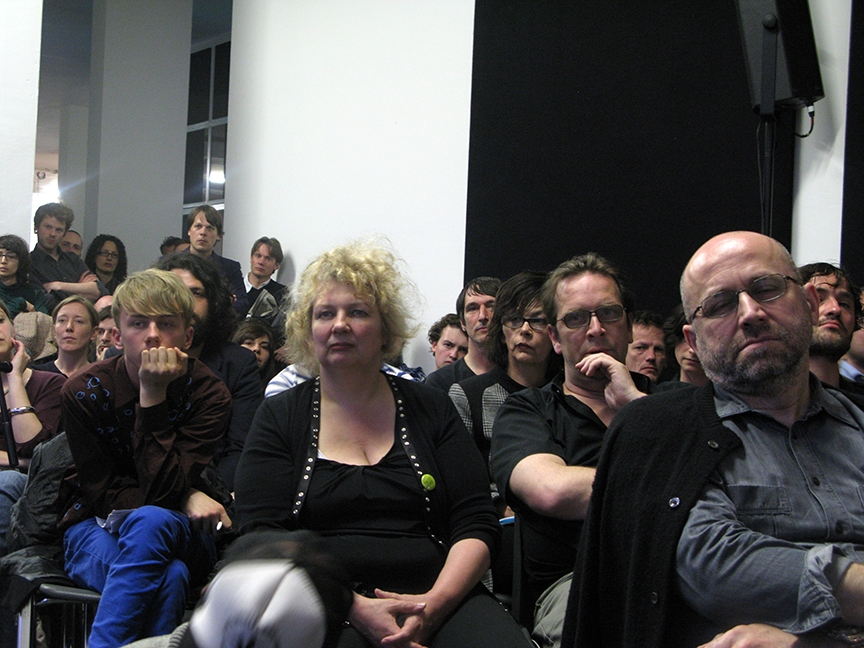Seminars / Lectures
Rainer Ganahl
May 4 - June 2, 2018
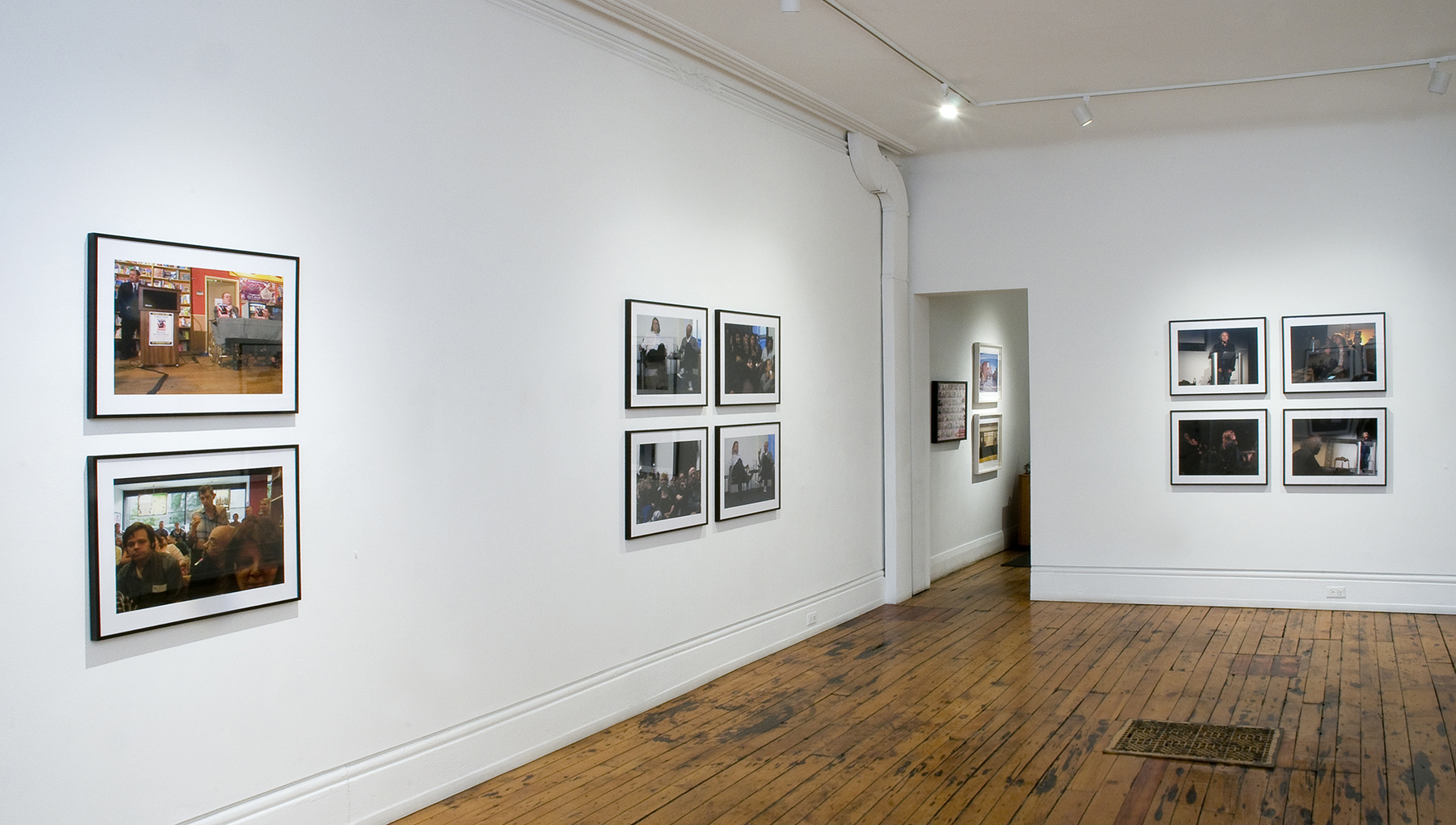
"My S/L is an ongoing project attempting a “representation of intellectuals” within their working environment. Since 1995, I have been auditing classes and attending public lectures of interest to me and taking photographs from the subjective position of a participant.
"These photographs are an observation of a field, namely critical cultural education, that is important for the productive reproduction of society. Education and knowledge are sites of contest and conflict as well as mirrors of tensions and fractions in society. Usually, they reproduce biased structures of privilege through high cost, selective access, and uneven distribution of material and informational resources. Education, pedagogy and knowledge are embedded in an ideological setting of the public and private sphere and often contradict their own content and liberal drive.
"It is no surprise, then, that I am encountering a variety of contradictions. As much as I am interested in the type of knowledge I am auditing, knowledge itself doesn’t usually show in a picture, with the exception of visual materials presented by the lecturer. It remains indexical and hinted at only through the title of the class or lecture. My visual records remain open to a variety of readings and don’t allow for knowledge consumption. "I am not interested in rendering these sometimes well recognized figures and their intellectual practices spectacular but, after all, the archive contains intellectual celebrities, and sometimes famous and spectacular visual material in the form of slide projections or films. A spectacularization of knowledge and its institutions is something more often undertaken by these institutions themselves, since they are mostly now inscribed in the competitive logic of the educational industry and performing outside their usual confines. I try to also address these questions, as well as the question of the overlapping of fields: theory in the arts, in architecture, etc. "My fragmented and somehow dilettante encyclopedia of S/L photographs doesn’t just map my interests, but also my local movements and presence. The list of the visited seminars and lectures can be read as an intellectual as well as topological travel log.
"This ongoing S/L photo series is part of a larger body of work called, Reading Seminars, Studying of Foreign Languages, Writing, etc, that I have been developing for more then a decade concerning similar issues: language and knowledge—its media and power—and the struggle of a critical public sphere."
-- Rainer Ganahl
From the web site of the Generali Foundation, Vienna:
Rainer Ganahl was born in Bludenz, Vorarlberg, Austria, in 1961. From 1986 to 1991 he studied at the University of Applied Arts in Vienna with Peter Weibel, at the ENSAD in Paris, and at the Art College, Düsseldorf, Germany, with Nam June Paik. Between 1990 and 1991 he studied at the Independent Study Program of the Whitney Museum in New York. Since 1990, Rainer Ganahl has lived mainly in the United States, particularly in New York.
After early forays into video animation work (from 1987) Ganahl became involved in the forms and languages of computerized spaces and data bases. He analyzed the structures and hierarchies that govern computers in a number of series entitled windows, file-catalog, and citY lisT (all from 1989), involving installations that would, on occasion, take up an entire room. His critical approach to post-colonial theory led Ganahl to create a set of works beginning in 1994 (e. g., Basic Japanese), which turned the laborious process of learning an “exotic” language into an art project. Cultural differences were also a theme of his Imported-Reading Seminars held from 1995 onward. The selection of current theoretical works from specific countries and the group study of these texts was documented and presented on video. The realm of academic training and education formed the background for his photographic series S/L (Seminars/Lectures). Besides this documentation of personalities from the world of academia, he also displayed thematically similar works by other artists in the Educational Complex exhibition, which he organized at the Generali Foundation in 1997. In the Austrian pavilion of the Venice Biennale of 1999, he presented his most recent works in conjunction with five other individual artists and teams. His preoccupation with language was further extended in interview projects such as Basic Canadian, where users of an idiom were differentiated according to their origin, education, and class background and queried as to their linguistic identity.
From the web site of the Wallach Art Gallery, Columbia University, NYC:
For more than twenty years, Rainer Ganahl's oeuvre has offered a subtle exploration of the points of overlap of art and learning by engaging both as mutually imbricated rather than mutually exclusive. Through the examination of preexisting practices and the production of new ones, he creates possibilities for image and knowledge production that partake of each other. Much of Ganahl's work falls into several ongoing series of distinct types: Libraries, S/L (Seminar/Lectures), Readings, Studies, and Dialogs. These series—each examining a different aspect of the formation of knowledge—comprise a variety of media, including photographs, videos, books, wall texts, and tapestries.
Ganahl's work is based on the documentation, in photographs, video, and other formats, of processes of learning. Sometimes he documents existing situations, as in his S/L series, where he attends and photographs seminars and lectures by leading scholars. He also creates his own educational environments, as in his Libraries, which are collections of scholarly books, intended to be perused by gallery visitors; and in his Readings, where he photographs and/or videotapes invited participants as they analyze theoretical texts with him. Ganahl also examines the processes and mechanics of education. His Studies are portraits of himself as a learning machine, documenting his efforts to study new languages; and his Dialogs, undertaken as either interviews or collaborations that explore cultural differences, engage with learning as a process outside educational or quasi-educational institutions.
Ganahl has had numerous solo exhibitions in Europe and New York and was selected as one of three Austrian representatives to the Venice Biennale in 1999. His work can be found in many major collections in Europe and the United States.
RAINER GANAHL with Sara Roofing
by Sara Roofing, The Brooklyn Rail, 5 Oct 2015
For twenty years, Rainer Ganahl has captured images of speakers and their publics during seminars and lectures for his ongoing series “Seminars/Lectures” (S/L). Other presentations of the S/L series include the Venice Biennale (2007), Wallach Gallery at Columbia University (2005), the Generali Foundation (1997), and at Max Protetch Gallery (1999). Sara Roffino caught up with Ganahl several times throughout the run of his current exhibition, Artists: Recent photographs from my S/L series, on view at Kai Matsumiya through November 1.
Sara Roffino (Rail): You’ve been working on this series “S/L” for exactly 20 years. How did the project begin?
Rainer Ganahl: It was Edward Said’s Representations of the Intellectual that inspired this project. He was always very influential to me, and in 1994 I was able to audit a class with him at Columbia. He made me realize that we do not really have visual ideas of intellectuals, not even of some of the most prominent names like Paul Virilio or Judith Butler. We rather have more conceptual ideas of them. We embrace their writing, we remember the experiences we have in relationship to their books, but we don’t necessarily know what they look like in person. We don’t visualize Habermas or Simone de Beauvoir, though there are a few exceptions, like Foucault. It was 1995 when I first started to photograph lectures and seminars—always including images of both the speaker and the audience. If I was photographing an art historian, I also included their projected slides. Now of course, people use digital projections and it’s rare if there is no media. Slavoj Žižek’s lecture “The Obscenity of Power” at NYU was the first seminar I came across where a non-art historian presented films on bulky televisions. I knew from very early on that the title of the series would be “S/L”, a reference to Roland Barthes’s seminal book S/Z, but it took me a year or two before I actually understood what I was doing. Before “S/L” though, beginning in the early 1990s, I had started a series I call Reading Seminars, where I function as the organizer or as a leader for communal readings. While the readings, which were predominantly of the texts of the people I eventually photographed for “S/L”, were taking place, I would capture photographs of all the participants, including myself. So from the very beginning, photographing people who are reading, listening, speaking, and reflecting has been a part of my practice wherever I was in the world.
Rail: At first it appears as a documentary practice, but it goes much deeper than that.
Ganahl: I’ve never felt content with the term “document.” Even when I was working with Reading Seminars I would enlarge the images to 20 by 24 inches, which resulted in something that is beyond a simple document—I always looked at it as an artwork. When I photograph Douglas Crimp, it is not only that I want to show how great Douglas looks—he has a very striking, Foucault-like appearance—I also pack the non-visual importance of his texts into these images, like his work in the fight against AIDS, which was very influential to me. This all constitutes meaning for me, or strings of meaning I want to share so that other people can learn from him and enter the works with their own experiences and histories. When I see his name and his images, I remember my time spent reading his texts and learning about gender identity and gay politics and the connections between his biography, AIDS, and art. Obviously, this aspect of the series is what I call indexical, or a reference to something that isn’t present visually. Engagement with the work depends on whether a viewer is already familiar with the artist or thinker. All the “S/L” sets are titled according to the title of the presentation or lecture, the hosting institution, the city where it took place, and the time of the event, for example “S/L, Jens Hoffmann, Martha Rosler, Jens Hoffmann in conversation with Martha Rosler, Art Basel, Basel 6/18/2010.” This straightforward information is important in understanding and experiencing the work as it develops over time.
Rail: You’re contextualizing these artists and thinkers within a historical framework.
Ganahl: I want to make a monument for the people involved—a monument to their way of thinking and reasoning, their struggles, their epoch, and their artistic, cultural, scientific, social, and political stakes. It’s not only about their texts, but also about the images they choose to discuss and project as well as their ways of living and the causes they are engaged with. For the show at Kai Matsumiya, I focus specifically on artists. All of the subjects, which include Jutta Koether, Werner Herzog, Ken Okiishi, Willem de Rooij, Jeff Wall, Harun Farocki, Yael Bartana, and others, are presenting their own artworks or are having it shown by art historians. I’ve been most focused over the past ten years or so on photographing artists, which partially reflects the lectures I’ve come to appreciate the most.
Rail: Do you think of the series as homage?
Ganahl: I don’t want to use the word homage. It’s too French, too male and too romantic, since it derives from homme, “man.” Maybe we should start speaking of femmage [Laughs.]. I also have to say that, even though I just used the word “monument,” I don’t think that’s quite right either. Let’s just think in terms of anti-monument.
Rail: At the same time, there’s something very human in these images.
Ganahl: Enlarging the photographs to 20 by 24 inches renders people beautiful. It recently occurred to me to compare my interest in people to that of Andy Warhol, who focused on celebrities and friends partying or posing in otherwise flamboyant, ecstatic, or narcissistic ways. I search for that visual delirium and beauty in the way people look when they think, speak, and listen—when they are completely committed and concentrated on a speaker. I really love watching people listen and speak. It is not a normal state. It’s actually a kind of paranormal state of focus. And I really like this simultaneous absence and presence due to moving in and out of various states of concentration: it exposes hints of people’s vulnerability. Attentive listening or speaking lifts the usual guard and control people have over their faces and expressions. They are really dedicated to something and they forget their appearance. There’s a big discrepancy between the way we imagine thinking looks and the way thinking actually looks.
Rail: Does showing what these people look like change the experience of their ideas?
Ganahl: No, of course not. Absolutely not. And that’s also a limitation. Showing intellectuals is not an extension of reading them. It isn’t a substitute for knowing the work or engaging with it. Both the strength and the weakness of this series is that if someone isn’t familiar with the artist represented, AA Bronson, for instance, their accessibility to the work is limited to just what they see, so they are less engaged with the visual and historical significance of the moment that is represented.
Rail: The result of which is that you are very much at the center of this—it’s as much about the historical contextualization as it is about your personal contextualization.
Ganahl: Yes, in a way, it’s a very biographical project. By showing a circle of people who have been important to me for all different reasons, I am telling a certain story about my own life. If I don’t like someone, I don’t go to photograph them. Most of the people I have photographed, I have learned something from. Many of them are people I am in touch with, or I have read their books. The artists in the current show are all people I think of as my ideal audience. In order for me to include someone in the series, I need to at least be interested in them and feel that we are working toward similar aims. It’s sort of like a primitive Facebook, with people you are either friends with or want to be friends with. We are not growing up intellectually on isolated islands. We are part of the world that other people share and help create, and I want to contribute to this.
Rail: Each series includes many elements in addition to the speaker. Can you talk a little bit about everything else that is documented in the images?
Ganahl: This series is also a very analytical work, where I am depicting a site of knowledge acquisition. For example, if the lecture is in a university we see who has the privilege of sitting there—it shows privilege and it shows lack of privilege. Are there only white people sitting there? Is the place shabby or is it clean? Is it an Ivy League university or is it Zuccotti Park? I really hope that future generations will find something to discover in these images, something they will be able to read about these moments and places.
Rail: The series also taps into larger implications of history and knowledge and where the two meet.
Ganahl: I have been building this series for twenty years, which is both a lot of time and no time at all. The history of the visualization of knowledge is very much related to technological progress, with the most important milestone of this progress being the printing press. The production of knowledge exploded after Guttenberg in a way not entirely different from the explosion we are experiencing right now with digital, cloud-based information. I hope that this project contributes something that can account for a certain historical moment within cultural history without simply pointing out the obvious. People are always enjoying or hating each other, and people are always learning from each other, though the way they do so changes over time: the clothing, the body language, and the settings change. Even the way we do or don’t pay attention to things and the way we multitask. We talk to different people and different media at the same time and even eat and drink in class. I hate it, but the open display of a multi-local and temporal presence is becoming the normal and I, too, am very guilty of these communication crimes, speaking with people while messaging, sending emails while talking or reading the news or Googling while listening to people’s presentations.
Rail: In addition to the TK photographic works in the show, there are two silkscreened banners hanging in the back of the gallery. One reads, “Why do we fail,” and the other reads, “Why do we fall?”. How are these works related to the “S/L” series?
Ganahl: The banners are a contribution to Mike Kelley, who I was able to meet a few times. In 1985 I was working at a gallery in Vienna that was showing his textile banner works. I had these pieces in mind, along with a general previously unarticulated existential question of what constitutes failure for an artist. In the first large-scale presentation of the “S/L” works, which was at the Generali Foundation in Vienna almost twenty years ago, I titled the show Educational Complex after Mike Kelley’s piece and included a work by him, which was of puppets placed on a blanket on the floor pretending to be lecturers and making fun of each other. Mike Kelley’s suicide made me think a lot about these questions of falling and failure.
Rail: And what do you think is the difference between falling and failing?
Ganahal: I think failing is the beginning of falling. Failing is a condition where you fall. You might be failing, but you still might be going. You might be not falling and still fail. But I think it’s possible that you can fall, really fall, without failing. And that’s where Mike Kelley comes in. He fell on the level of subsistence, but that doesn’t make him a failure. You might make a mistake and not immediately confront the consequences, but when you fall you are on your ass, you ruin your shirt, you ruin your hat, you ruin your car, you ruin your equilibrium. There are different gradations of falling. I think every artist needs to have their own criteria of success and subsequently their own measure of failure. As for me, the most desirable accomplishment, of course, would be relative independence from all the usual expectations and superego formations that one usually trips over.
An interview with Rainer Ganahl, from Issue 1.1 / 2011: 15-20 of continent
Rainer Ganahl's S/L
Rainer Ganahl has made a study of studying. As part of his extensive autobiographical art practice, he documents and presents many of the ambitious educational activities he undertakes. For example, he has been videotaping hundreds of hours of solitary study that show him struggling to learn Chinese, Arabic and a host of other languages. The stacked boxes of tapes are then presented like minimalist monoliths, dense archives of effort.
About fifteen years ago, Ganahl began photographing the lectures that he attends. At the time, he hadn’t seen anyone else doing it, so besides his spare selection of images of the speaker and the audience, much of the time the lectures would just pass into memory, undocumented, or recorded in writing alone. Since then, he has felt the transition to digital cause a significant shift in his process. At the same time, he has seen the habit become ubiquitous as others photograph, record, and videotape the lectures all around him.
In keeping with the theme of this inaugural issue of continent., can we propose each small grouping of photographs that result an isthmus stretching between two disparate bodies of mind? The first being the body of the lecture as spelled out in the title of each work – the experience of the event in all its constituent parts. The second is the body of the recipient, the listener, in this case an artist, who plays a minimal role just beyond the prescripted behavior of sitting and listening. He uses a gesture of documentation to draw a line between himself and the event, creating an artwork.
Františka + Tim Gilman: As we mentioned before, the theme of the magazine for this issue is "isthmus." It seems like a very good way into your work, and it leads us to ask what connection you see between your photographs of the lecture and the lecture itself?
Rainer Ganahl: The relationship is of course a concrete, pictorial one, or if you want a mimetic one but also an abstract one because the photographs carry the title of the lecture, the names of the lecturers, the site, the institution and the time of the lecture. Photos are fixed moments of time and can reproduce images displayed and reproduce visuals presented at a moment but they don’t come with time based recordings that video or sound takes are offering. What remains of a lecture is usually just the memory, some notes and all the announcements of it. In my case I end up with a visual product I declare as my artwork. It might not differ from any snapshot taken by any other student or member of the audience but I do this in a semi-systematic way with certain rules and procedures I have set up. While I am at a lecture I am mainly focusing on the lecture itself. Last night I went to one of Slavoj Žižek which demanded quite some concentration. I even was asking him a question at the end. I took photos as well but still didn’t lose track of the lecture. I didn’t walk around, I was not preoccupied by where I was sitting and what light I was having like some of the other photographing and filming people in the room who came and left, moved around and tried to capture him from this and that angle, from close and far. I just sat there and concentrated on the lecture and yet managed to take about 30 or so images of him, the public around me and of the film clips he presented.
Once the lecture is over the story changes: it all becomes a question of the images, their selection, their visual qualities, their labeling and archiving. The function of the images also change: not only do they stand for an intellectual event in a row of lectures that become part of my intellectual history within many possible such histories but they also have to function as art, something not everybody else with images of lecturers demands of their images. This is my specific claim as an artist to impose them as artworks. And as with all artistic propositions the offer can be accepted or rejected. I basically spend my life trying to do exactly that: making what I declare as art, offering something to anybody interested in it as my art, an offer that is not and will never be accepted as such by all people.
F+T: What are your criteria for selection, i.e. how do you choose which lectures to photograph, by lecturer, by topic, or do you photograph any and every lecture you can?
RG:As everything in my life, I go by my interest which is the result of many factors. If I am aware of a lecturer, read his books or appreciate his works my interest of attending his much higher than if I am not aware of it. I usually don’t go to lecturers simply based on their subjects—something that can happen of course, if the subject, the title of the lecture is promising or at the heart of my interest. Sometimes I also wait for years to get a change to photograph certain people but I do that in a very low-level “keep your ears up” mentality and not in a systematic scanning of all channels and possibilities. I do not go into philosophy departments and photograph everybody teaching there. I go with the flow—and unfortunately a great deal of great talks I also miss because I hear too late of them. Often, I also stumble into them by traveling, by getting emails from friends and by simply being in the right spot at the right time. Somehow you could look at my lecture par cours as some kind of loose intellectual flâneurism. If you know of interesting lectures and events, please, let me know.
F+T: Is your selection of images more of a production or post-production method? That is, do you take a lot of photos and select only a few images from each lecture, or do you take them very selectively? Do you have a particular methodology for the selection of images?
RG: This all changed a bit with the arrival of digital photography. In the beginning I had to pay a lot of money for film developing. Hence, I was taking either one role - 36 images - or half a role - 13 images - depending on who talked and whether they projected images. With the unlimited capacity of digital imaging I easily end up between 30 and 150 images of one event still depending of whether images are presented or not. In the first years of that project when I wasn’t fully aware yet of what I was doing, I printed at least 2 images of any lecture and sometimes three or even four, a choice that was also constrained by costs. But again, since I have a web site and since images can easily be selected and presented on my web site without generating remarkable costs I have now more and more pain to reduce them to less than ten or eight images for an event. Now, before I have them printed which really is expensive, I can present them already as artwork on my web site without any immediate costs. Thus the economic factor is at the end of the chain which enables me to be more ‘generous’ and include more images. Over the last years I have been mostly selecting at least four photographs for a lecture unit but recently also as many as ten. But so far only one set above four images has been actually printed and sold. What might sound even more shocking is the likely fact that if a curator or a collector demands me to reduce the number of images due to costs, I might compromise at this current stage if the images have not been yet printed or published outside my own web site. This means that to a certain degree any selection that has only seen publication on my web site and not yet been produced runs the risk to change in numbers of images included. Needless to say, I am the last one that finally makes a decision and I do honor all given earlier decision if those were final.
F+T: How do you feel the act of photographing the lecture affects your reception of the contents of the lecture? And your recollection afterwards, do you remember the lecture more having photographed it, or just having sat and listened?
RG: As mentioned above, I get very little distraction from photographing since I can multitask well and do not obsess about the quality of the image: I photograph from where I am and listen with my ears and not my eyes. I am not sure whether the images serve as a mnemonic devise to the content of the lecture if there are no images involved but they at least remind me that the lecture existed, the title of the lecture and the name of the people and institutions involved. The titles of the hundreds of lectures I took during the past 15 years can also be read as an essay of theoretical life in that period. This will be come more and more visible as time passes by. These images age much better than I do.
F+T: You mentioned at the outset of our discussions that you started this practice some time ago and have seen the practice of photographing lecturers become more commonplace. Why do you think that this shift has taken place?
RG: The answer is very simple. Photographing is now free of any charge and hence omnipresent. You buy a phone or any other personal digital assistant and it has a camera integrated in it whether you want it or not. There is no need to develop images and there is no hassle to keep images, to distribute images, to organize images and save them. It is all virtual, not creating any costs and doesn’t require any efforts. You don’t spend twenty dollars for photo-developing anymore, you don’t need to walk anymore to your pharmacy or your photo shop to drop off and return to pick up and pay. You don’t need to go to the post office to send somebody a picture. You have a program like Photoshop already built into your camera. Photographing is now a thing for everybody—with functioning cameras made for two year olds. It is technically now nearly impossible to make bad images. The image quality is virtually guaranteed by cheap, high performing, mini-computers packed into miniscule cameras. With all these technological changes, we are undergoing now a cultural paradigm shift that includes permanent recording (not only still image taking) of everything. I wonder even whether babies are just born to be photographed—at least a process where the first photograph is right there. What is interesting now, is how the law is trying to catch up. I am experiencing and expecting more restrictions on photographing and recording—something already in place in many museums and in certain galleries—as the recording devices become more and more invisible and undetectable. It is an interesting cat and mouse play and will end up with some of us that are photographing the world around us in court. The world has become very transparent and everybody is contributing to it with social networking technologies—like twitter and Facebook—that are designed to monitor and communicate every step we make in our lives.
F+T: Why did you start the practice? As a way to remember, or to capture the experience of the lecture and the environment there?
RG: A couple of years earlier I started to photograph my own reading seminars as part of my art work with results that surprised me positively. I really liked these images of students and people discussing heavy non-fiction with me. The reading seminars justified this kind of pictorialism. Then in 1995 I had the chance to attend an entire seminar by Edward Said entitled “The Representation of Intellectuals at Columbia University,” which really gave me the idea to start this series. Why not also photograph these lectures I visit all the time since this really is a way of representing intellectuals?
F+T: The constellation of images and the title seem like a kind of portrait, do you agree? If so, is it a portrait of the speaker, of yourself, or of the event?
RG: Well, to follow up on the previous question the lectures are more than just portraits of lecturers since I include not only the speakers but also the audience, an audience that is not named or specifically highlighted as is the speaker. So if we stick with the metaphor of the portrait we would have to extend it also to the environment, the class room, the lecture hall, the arrangements of seats or benches, tables, lecture stands and other stuff typically seen on my images. Often the walls are decorated or even tagged with graffiti or posters and other stuff. There is a big difference between a small seminar room at the English Department of Columbia University, full with books and cabinets and a lecture room at a Paris or Frankfurt university that accommodates 50 to 150 people. We should, maybe, also distinguish between lectures that are one time events—mostly open to the public, free of charge or paid—and events that are weekly, closed to the public and held mostly in universities that can cost fortunes or be paid by the State as it is still predominantly the case in continental Europe. All this, of course, is not necessarily announced in the title of the lecture and is subject to information that isn’t visible on the images.
To a certain degree we see also portraits of a general privilege when it comes to the public of certain institutions that are highly selective and extremely costly without forgetting that most of the lectures are dealing with theory, art, philosophy and other highbrow subjects. In general, I would say we see very little if we don’t know already what’s going on, who the lecturer, the institutions, the context are in which we subsequently can zoom into variants like sexual, racial, or age-related make-up without ignoring clothing fashions, hair styling, body mannerisms, gadgets and stuff.
F+T: Do you see a relation between this body of work and your other work, for example your language studies?
RG: Everything I do is “unfortunately” related. I say unfortunately because this makes my work not so easy to grasp. The relationship to the language studies is relatively clear since both are originally grounded in the domain of education and knowledge production. Nearly all my work comes across that nexus where knowledge and power are addressed. I was at one point wondering what the relationship was to some of my earlier indexical work where I was happy alone with footnotes from books painted on the walls: I came to understand that both are just different manifestations of knowledge and information.
F+T: Do you foresee continuing the series indefinitely, or is there an end to it?
RG: I think that I will continue this series indefinitely or to be more precise, as long as I go listen to lectures and want to learn something which brings me to your previous question: What do the reading seminars, language studies, historical research and lecture hopping have in common: I learn something.













